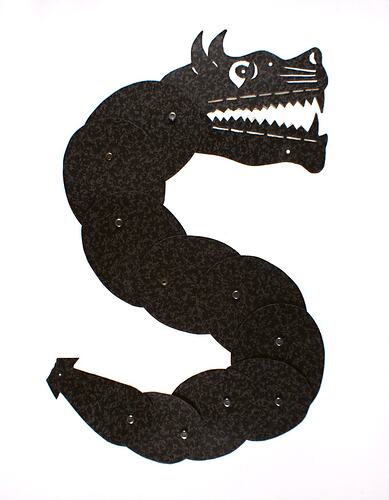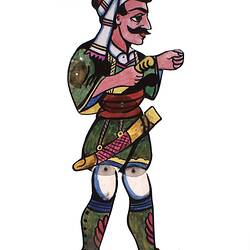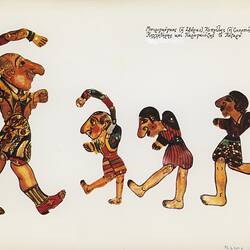Summary
This puppet was made in 1977 by the Greek puppeteer and popular artist Abraam (Antonakos) in Melbourne, prior to the beginning of his performances because he forgot to bring the original from Athens. After Abraam, Dimitri Katsoulis, with who, Abraam left most of the collection of puppets, used the puppet in performances in Victoria and in South Australia from 1978 to 1991. Dimitri Katsoulis migrated to Australia in 1974 to escape a regime that repressed Greek artists. He had trained in Greece with theatre and film companies as an actor and technician. A master of the traditional Greek shadow puppet theatre, his performances explored contemporary issues such as the isolation of migrant women and children. Unable to obtain funding and support, he returned to Greece in 1991, leaving his entire collection to the people of Victoria. It includes 32 shadow puppets and around 170 props, set backdrops and technical tools and stage equipment. Dimitri has since returned to Melbourne and assists the Museum to continue to document this rich art form within both local and international contexts.
The snake is a character in the centuries-old Greek Shadow Puppet Theatre (Karaghiozis) tradition. It can be fatal. It appears only in the plays 'Alexander the Great and the Cursed Snake' and in the 'Haunted Tree'. In the play 'Alexander the Great and the Cursed Snake', the snake has moved into a cave and has become the greatest fear of the town, having devoured many, including many brave men who have dared to go up against it. In desperation, the Veziris (the Veziris - originally a Persian term for a high-ranking political, and sometimes religious, advisor or minister, often to a Muslim monarch such as a Sultan) offers his daughter as a reward to whoever can kill the snake and save the world. Alexander the Great, familiar with the general fear provoked by the snake, battles with it and manages to kill it and then departs. Karaghiozis, who helped him, wants to profit from this situation. He convinces Hatziavatis [another Greek Shadow Puppet Theatre character] that he killed the snake and they go to the Vizier (the Veziris) to claim the reward. He realises the scam and orders Thervenagas to pay them with a strong beating.
The puppet is manipulated by three puppet rods [there are many examples in the collection] mounted one on the chin, one under the chin to open and close the mouth, and one on its tail.
Information supplied by Greek Shadow Puppet Theatre master Dimitri Katsoulis, 2007.
Physical Description
A two-dimensional puppet in twelve (12) jointed parts, made of black cardboard, in the form of a snake. The head is dragon-like, with horns, a moveable lower jaw and many teeth. The body segments are oval in shape. The facial features are cut out of the cardboard as if for stencilling.
Significance
This collection of puppets, props, stage sets, and technical tools and equipment relating to traditional Greek Shadow Puppet Theatre is unique in Australia and rare in international public collections. The history of Greek Shadow Puppet Theatre, its puppet characters and the methodology of its performance has been recorded in partnership with the puppet master to whom the collection belonged. The collection is highly significant both as documentation of an important cross-cultural, centuries-old art form, and as an example of the transnational migration of cultural activity between Greece and Australia. It is a collection which was created and performed in Greece and Australia from the mid to late twentieth century, by two puppet masters, who transported the tradition between two countries. Abraam Antonakos came to Australia in 1977 to perform the puppet theatre and then deposited the puppets with Dimitri Katsoulis, who had migrated to Australia in 1974. Dimitri's story becomes one of migration experience, cultural maintenance and adaptation, and finally return migration and the discontinuance of this cultural art form in Australia.
More Information
-
Collection Names
-
Collecting Areas
-
Acquisition Information
Purchase
-
Artist
-
User
Mr Abraam Antonakos, Athens, Greece, 1960-1977
Abraam made the puppet in Greece, and used it in performances during the 1960s and 1970s; and then in Victoria in 1977. -
User
Mr Abraam Antonakos, Victoria, Australia, 1977
Abraam made the puppet in Greece, and used it in performances during the 1960s and 1970s; and then in Victoria in 1977. -
User
Mr Dimitri Katsoulis, Australia, 1978-1991
Dimitri was given the puppet by Abraam in 1977 and then used it in his performances in Australia until 1991. -
Inscriptions
On third body segment, two words in Greek text; 29/11/1977
-
Classification
-
Category
-
Discipline
-
Type of item
-
Overall Dimensions
21 cm (Length), 126 cm (Height)
-
References
[Link 1] Malkin, Michael, R. Traditional and Folk Puppets of the World, A.S. Barnes & Co., Inc., N.J., 1977; Simmen, Rene, The World of Puppets, Elsevier, Phaidon, London, 1975; Hogarth, Ann & Bussell, Jan, Fanfare for Puppets!, David & Charles Publishers Ltd, USA, 1985; Yayannos, A & Ar and Dingli, J. The World of Karaghiozis, 1976
-
Keywords
Cultural Maintenance, Greek Communities, Greek Immigration, Karaghiozis Theatre, Shadow Puppetry, Theatres, Working Life



